The Russian military will likely surpass 1 million casualties in its war on Ukraine this summer, according to one of the world’s leading think tanks, reflecting the staggering human toll of President Vladimir Putin’s assault on his neighbor.
Around 250,000 of these Russian soldiers have died, the Washington-based Center for Strategic and International Studies (CSIS) said in a report Tuesday.
The Ukrainian military has also suffered heavy losses, with 400,000 casualties, including 60,000 to 100,000 soldiers killed, it said.
Surpassing 1 million killed and wounded would be “a stunning" and grisly milestone for Russia and showed “Putin’s blatant disregard for his soldiers,” according to the report. To put this figure in historical perspective, it is five times as many deaths as all Soviet and Russian wars since World War II.
CSIS arrived at its figures by collating and analyzing estimates by the American and British governments, as well as other sources such a review of Russian obituaries and cemetery registries by independent Russian news organization Meduza.
While stark, the toll roughly tallies with previous estimates given by Western intelligence agencies, which have said that around 1,000 Russian troops are killed or injured every day.
It's impossible to officially confirm the statistics because Ukraine does not release casualty data and Russia's is widely believed to be an undercount.
Putin annexed Ukraine’s Crimea Peninsula and began supporting pro-Russian separatists in the east of the country in 2014. But the CSIS figures relate to the period starting with the Kremlin’s full-scale invasion of Ukraine in February 2022.

The Russian leader's justification for this blitzkrieg on Kyiv, the Ukrainian capital, mixed ahistorical fallacy — asserting Ukraine has never been a real independent country — with complaints that NATO enlargement had risked his country's border security.
However, his tank columns were quickly pushed back in a stunning defense by Ukraine. Since then, his forces have reverted to attritional trench warfare, attempting to wear down Ukraine by throwing forward waves of troops in what analysts call “meat grinder” tactics.
As both side dug in, progress has been achingly slow, with CSIS putting the rate of Russian advance at around 165 feet a day, and capturing only 1,930 square miles — 1% of Ukrainian territory — since January 2024. That’s less than the famously pyrrhic Somme offensive in World War I, in which British and French troops advanced 263 feet per day.
From the skies, Russian bombers and drones have launched almost nightly attacks on Ukrainian civilians and infrastructure such as power grids. This continued overnight into Wednesday, with Russia launching 95 attack drones and killing at least 10 people in the past 24 hours, Ukraine's air force said.
Ukraine has responded by targeting military sites inside Russia, including Sunday's remarkable operation dubbed "Spiderweb" in which it fired more than 100 drones at multiple air bases — one of them 4,000 miles from Ukraine — after smuggling them in the back of trucks.
Kyiv's intelligence agencies followed this up Tuesday by detonating underwater explosives on one of the supports for the Crimean Bridge, a road and rail link built in 2018 and used to transport military supplies to the annexed peninsula.
Even so, Putin — as well as Russian and American lawmakers — have stated that they believe the Kremlin has the battlefield advantage. Russia may be losing more troops and materiel, but it also has a larger population from which to draw and greater military manufacturing capacity.

On the flip side, some experts believe that these Russian losses are unsustainable if the United States and other Western allies continue to support Ukraine’s defensive effort.
For Putin, “the war is such a disaster, and the Russian military has reached a point where from sometime this summer, its capability is all downhill: less armor, less ammunition, less resources, less motivation,” Richard Dearlove, the former head of Britain’s MI6 intelligence agency, told NBC News in an interview in April. “But Putin doesn’t have a reverse gear on his policy.”
Meanwhile, two rounds of American-brokered peace talks in Istanbul show no signs of progress on ending the war.
Russia is demanding nothing less than Ukraine’s full surrender and future subservience; Kyiv says it wants a ceasefire but that such an existential capitulation would be a nonstarter.
President Donald Trump has shifted from the avowedly pro-Ukraine stance of his predecessor, President Joe Biden.
Trump has offered a string of concessions to Moscow, while demanding Kyiv make sacrifices. At the same time, he has called Putin “crazy” for continuing to bomb Ukrainian civilians and has threatened to walk away from the process.

